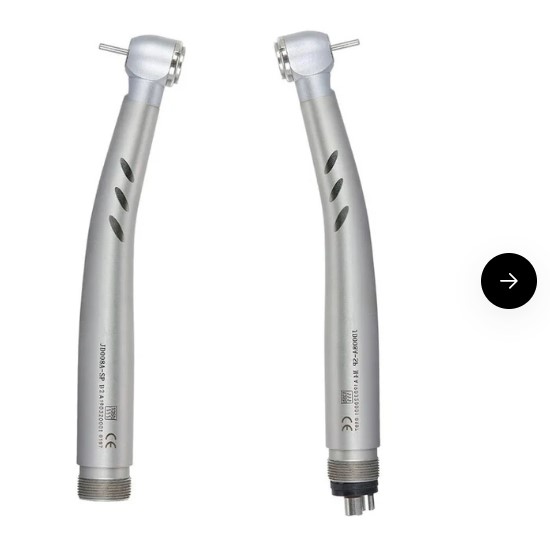
Dental handpieces are among the most essential tools in any dental practice. Whether performing routine cleanings, restorations, or complex surgical procedures, high-quality handpieces provide precision, efficiency, and comfort. Modern handpieces are designed with advanced technology, ensuring smooth operation, reduced vibration, and optimized control.
In this guide, we will explore high-speed handpieces, low-speed handpieces, prophies, scalers, curing lights, and electric motors. Understanding their features and benefits will help dental professionals choose the right equipment for their needs.
High-Speed Dental Handpieces
What Are High-Speed Handpieces?
High-speed dental handpieces are primarily used for procedures requiring fast cutting, such as tooth preparation for fillings, crowns, and bridges. These handpieces typically operate at over 300,000 RPM, allowing dentists to remove tooth material quickly and efficiently.
Key Features of High-Speed Handpieces
-
Air-Driven Mechanism: Most high-speed handpieces use compressed air for operation, making them lightweight and easy to handle.
-
3-Way Spray System: Ensures effective cooling of the tooth and bur during operation.
-
Ceramic Bearings: Provide smooth rotation and longer lifespan.
-
Push-Button Chuck System: Allows quick and easy bur replacement.
-
Minimal Vibration: Enhances precision while reducing operator fatigue.
Advantages of High-Speed Handpieces
-
Increased Efficiency: High RPM speeds allow for faster tooth preparation.
-
Improved Patient Comfort: Less pressure is required, reducing discomfort during procedures.
-
Enhanced Durability: Modern materials and lubrication systems increase longevity.
Low-Speed Dental Handpieces
What Are Low-Speed Handpieces?
Low-speed handpieces operate at speeds between 5,000 and 40,000 RPM, making them ideal for polishing, finishing, and cavity preparation. These handpieces are often used in conjunction with high-speed handpieces for comprehensive dental care.
Key Features of Low-Speed Handpieces
-
Interchangeable Attachments: Can be fitted with contra-angle heads, straight heads, and polishing cups.
-
Variable Speed Control: Provides greater control for delicate procedures.
-
Electric and Air-Driven Options: Offers flexibility in operation.
-
Durable Construction: Ensures longevity and reliability.
Benefits of Low-Speed Handpieces
-
Versatile Applications: Suitable for polishing, contouring, and removing soft decay.
-
Smooth Operation: Produces minimal noise and vibration, improving both patient and practitioner comfort.
-
Enhanced Precision: Ideal for finishing restorations and shaping composite materials.
Prophylaxis Handpieces (Prophies)
What Are Prophylaxis Handpieces?
Prophylaxis handpieces are designed for professional dental cleaning. They work with prophy angles and paste to remove plaque, stains, and tartar efficiently.
Features of Prophies
-
Cordless and Air-Driven Models: Provides flexibility for different dental setups.
-
Ergonomic Design: Reduces hand fatigue during prolonged use.
-
Low-Speed Rotation: Prevents heat build-up and enamel damage.
Advantages of Using Prophies
-
Effective Cleaning: Removes surface stains and bacteria.
-
Comfortable for Patients: Smooth operation minimizes sensitivity.
-
Compatible with Multiple Attachments: Allows use of different prophy angles for specific needs.
Dental Scalers
What Are Dental Scalers?
Scalers are essential for removing hardened plaque (calculus) and tartar from teeth. These tools help prevent gum disease and tooth decay.
Types of Scalers
-
Ultrasonic Scalers: Use high-frequency vibrations to break down tartar.
-
Manual Scalers: Require hand-scraping but provide precise control.
-
Piezoelectric Scalers: Utilize ceramic vibrations for effective scaling.
Benefits of Dental Scalers
-
Efficient Plaque Removal: Helps maintain optimal oral hygiene.
-
Prevents Periodontal Issues: Reduces the risk of gum disease and cavities.
-
Comfortable for Patients: Minimizes discomfort compared to manual scaling.
Curing Lights
What Are Curing Lights?
Curing lights are used in dental restorations to harden composite materials quickly and efficiently.
Types of Curing Lights
-
LED Curing Lights: Energy-efficient and long-lasting.
-
Halogen Curing Lights: Traditional but still widely used.
-
Plasma Arc Curing Lights: Offer rapid curing times.
Benefits of Curing Lights
-
Fast and Effective Hardening: Reduces chair time for both dentist and patient.
-
Portable and Wireless Options: Enhances usability and convenience.
-
Improved Bond Strength: Ensures durable dental restorations.
Electric Motors for Dental Handpieces
What Are Electric Dental Motors?
Electric motors provide a consistent and precise power source for dental handpieces. Unlike air-driven models, they offer greater torque and control.
Features of Electric Motors
-
Adjustable Speed and Torque Settings
-
Quieter Operation Compared to Air-Driven Handpieces
-
Minimal Maintenance Requirements
Advantages of Electric Motors
-
Greater Precision: Essential for complex restorative procedures.
-
Smooth and Consistent Performance: Reduces chatter and vibration.
-
Energy Efficiency: Consumes less air and requires less maintenance.
Choosing the Right Dental Handpiece
When selecting a dental handpiece, consider the following factors:
-
Type of Procedure – High-speed for cutting, low-speed for finishing.
-
Power Source – Air-driven vs. electric motors.
-
Handpiece Material – Lightweight but durable.
-
Ergonomics – Comfortable grip to prevent hand fatigue.
-
Maintenance Requirements – Easy lubrication and cleaning.
Investing in high-quality dental handpieces ensures better treatment outcomes, increased efficiency, and improved patient satisfaction.
Conclusion
Dental handpieces are indispensable tools for every dental professional. From high-speed and low-speed handpieces to scalers, prophies, curing lights, and electric motors, having the right equipment enhances precision and patient comfort.
Explore the latest dental handpiece technology to find the perfect fit for your practice.





Leave a Reply